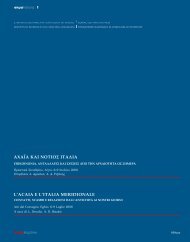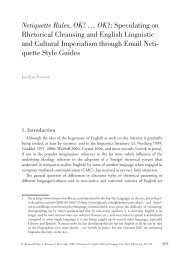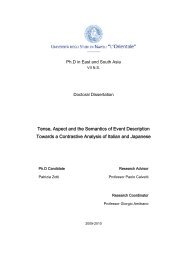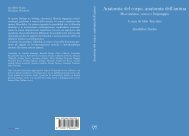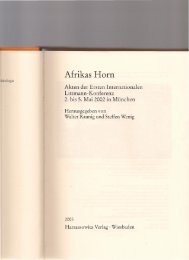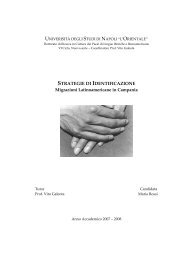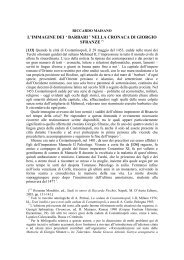Tesi di dottorato “Giovane donna in mezzo 'l campo apparse”. Figure ...
Tesi di dottorato “Giovane donna in mezzo 'l campo apparse”. Figure ...
Tesi di dottorato “Giovane donna in mezzo 'l campo apparse”. Figure ...
You also want an ePaper? Increase the reach of your titles
YUMPU automatically turns print PDFs into web optimized ePapers that Google loves.
<strong>Tesi</strong> <strong>di</strong> <strong>dottorato</strong><br />
<strong>“Giovane</strong> <strong>donna</strong> <strong>in</strong> <strong>mezzo</strong> ’l <strong>campo</strong> <strong>apparse”</strong>. <strong>Figure</strong> <strong>di</strong> donne guerriere nella tra<strong>di</strong>zione<br />
letteraria occidentale<br />
Cecilia Latella<br />
Questa tesi si concentra sul tema delle donne guerriere dall’antichità agli albori del ‘600,<br />
analizzandolo <strong>in</strong> particolare da un punto <strong>di</strong> vista filologico-narrativo.<br />
Il capitolo I segue la circoscrizione del mito delle Amazzoni da comunità aberrante, costruita <strong>in</strong><br />
negativo sulla società greca, a guerriera s<strong>in</strong>gola, la cui morte sollecita la partecipazione emotiva<br />
dell’u<strong>di</strong>torio, come avviene nei casi <strong>di</strong> Pentesilea e <strong>di</strong> Camilla.<br />
Il capitolo II ripercorre le mo<strong>di</strong>fiche occorse al tema nella letteratura francese me<strong>di</strong>evale <strong>in</strong> seguito<br />
alla cristianizzazione e al feudalesimo, quando un processo <strong>di</strong> cortesizzazione <strong>in</strong>veste la<br />
rappresentazione delle donne guerriere, attribuendo loro la capacità <strong>di</strong> <strong>in</strong>namorarsi e ammettendole<br />
qu<strong>in</strong><strong>di</strong>, <strong>in</strong> seguito al matrimonio e alla conversione, all’<strong>in</strong>terno della fazione sostenuta dal pubblico.<br />
È nella letteratura cavalleresca italiana, analizzata nel capitolo III, che emergono con maggiore<br />
evidenza motivi testuali dest<strong>in</strong>ati ad una lunga durata, quali il travestimento, il cambio <strong>di</strong> sesso, la<br />
caduta dell’elmo e il duello prematrimoniale.<br />
I capitoli IV e V si concentrano sul Morgante, l’Orlando Innamorato e l’Orlando Furioso,<br />
seguendo la progressione che porta la <strong>donna</strong> guerriera a <strong>di</strong>ventare la capostipite <strong>di</strong> una <strong>di</strong>nastia <strong>in</strong><br />
seguito all’unione con l’eroe. Nel Furioso, Bradamante e Marfisa sono assunte quali portavoci della<br />
querelle des femmes, <strong>in</strong>erente al <strong>di</strong>battito sulla superiorità dei sessi l’uno sull’altro e alla<br />
<strong>di</strong>stribuzione dei ruoli generici nel pubblico come nel privato.<br />
Il passaggio dal romanzo al poema epico riporta <strong>in</strong> auge la morte delle guerriere quale sistema <strong>di</strong><br />
espulsione delle deviazioni amorose dalla tessitura bellica della trama. Nella Gerusalemme<br />
Liberata, <strong>di</strong> cui si tratta nel capitolo VI, la <strong>donna</strong> guerriera e la sua morte <strong>di</strong>ventano uno dei punti<br />
focali del poema, <strong>in</strong> cui si <strong>in</strong>crociano le istanze dell’<strong>in</strong>comunicabilità, della menzogna, della<br />
maschera, <strong>in</strong> una conflagrazione tra i desideri <strong>in</strong>espressi e quelli realizzati attraverso proiezioni del<br />
sé.<br />
Il reimpiego delle formule ariostesche e tassesche <strong>in</strong> Francia, Inghilterra e Spagna è <strong>di</strong>scusso negli<br />
ultimi tre capitoli della tesi. L’utilizzo <strong>di</strong> donne guerriere quali capostipiti <strong>di</strong> <strong>di</strong>nastie si ritrova<br />
nell’Espagne Conquise <strong>di</strong> Nicolas de Montreux (capitolo VII) come nella Faerie Queene <strong>di</strong> Spenser<br />
(capitolo VIII). In quest’ultimo, Britomart è <strong>in</strong>serita <strong>in</strong> un contesto allegorico, <strong>in</strong> base al quale la sua<br />
militanza arriva a significare la Castità attiva e l’Equità.<br />
Il capitolo IX offre una s<strong>in</strong>tesi del successo delle guerriere nei libros de caballerías spagnoli. È <strong>in</strong><br />
particolare il riba<strong>di</strong>mento della necessità <strong>di</strong> restaurazione normativa che <strong>in</strong>teressa gli autori<br />
spagnoli, come si rende evidente nella decostruzione della performance guerresca <strong>di</strong> Ismenia nella<br />
Jerusalén Conquistada <strong>di</strong> Lope de Vega.<br />
Il lavoro si conclude del<strong>in</strong>eando le pr<strong>in</strong>cipali l<strong>in</strong>ee <strong>di</strong> rifunzionalizzazione delle storie delle<br />
guerriere all’<strong>in</strong>izio del ‘600. Chiude il volume una vasta bibliografia.
Doctoral thesis<br />
<strong>“Giovane</strong> <strong>donna</strong> <strong>in</strong> <strong>mezzo</strong> ’l <strong>campo</strong> <strong>apparse”</strong>. Warrior women <strong>in</strong> Western literary tra<strong>di</strong>tion<br />
Cecilia Latella<br />
This thesis analyses the theme of warrior women from ancient times until the start of XVII century,<br />
ma<strong>in</strong>ly from a narrative and philological po<strong>in</strong>t of view.<br />
Chapter I dwells on the narrow<strong>in</strong>g of the Amazonian myth from describ<strong>in</strong>g an aberrant community,<br />
built <strong>in</strong> reverse to Greek society, to explor<strong>in</strong>g s<strong>in</strong>gle characters, as Penthesileia and Camilla, whose<br />
death can stir the au<strong>di</strong>ence’s emotional reaction.<br />
Chapter II observes the mo<strong>di</strong>fications occurred to the theme <strong>in</strong> French me<strong>di</strong>eval literature, as a<br />
consequence to the <strong>in</strong>terven<strong>in</strong>g Christianity and feudalism. Courtly culture drew authors to <strong>in</strong>clude<br />
warrior women as participants to the love relationships that are to be found <strong>in</strong> romans d’antiquité<br />
and chansons de geste. Follow<strong>in</strong>g conversion and marriage to a Christian knight, the war activities<br />
of a woman may be <strong>in</strong>tended positively, <strong>in</strong> support of the approved faction with<strong>in</strong> the war.<br />
Chapter III shows how textual motifs dest<strong>in</strong>ed to a long success, such as the sex change, the male<br />
<strong>di</strong>sguise, the fallen helmet and pre-nuptial duel, take roots <strong>in</strong> Italian popular chivalric poetry as it<br />
beg<strong>in</strong>s to develop <strong>in</strong>dependently from the French sources.<br />
Chapters IV and V, cover<strong>in</strong>g the three ma<strong>in</strong> Italian romances (Pulci’s Morgante, Boiardo’s Orlando<br />
Innamorato and Ariosto’s Furioso), follow the rais<strong>in</strong>g status of warrior women as they are created<br />
ancestors to rul<strong>in</strong>g dynasties. In the Furioso, Bradamante and Marfisa are employed as speakers for<br />
the querelle des femmes, <strong>in</strong>terven<strong>in</strong>g about the superiority of one sex on another and about the<br />
performance of gender roles <strong>in</strong> a public as well as <strong>in</strong> a private context.<br />
The shift from romance to epic poetry causes a renewed <strong>di</strong>splay of warrior women’s death, as a<br />
mean to expel romantic deviations from the army-centred plot. In the Gerusalemme Liberata<br />
(<strong>di</strong>scussed <strong>in</strong> chapter VI), the death of Clor<strong>in</strong>da becomes the cross<strong>in</strong>g po<strong>in</strong>t between the<br />
undercurrent issues of the poem – <strong>in</strong>communicability, lies, deceits – as she f<strong>in</strong>ds herself torn amidst<br />
unexpressed desires on one hand, and desires projected on other people that the self on the other.<br />
The last three chapters survey the adaptations of Ariosto’s and Tasso’s schemes <strong>in</strong> France, England<br />
and Spa<strong>in</strong>. The device of us<strong>in</strong>g warrior women as dynasties’ ancestors is exploited <strong>in</strong> both the<br />
Espagne Conquise, by Nicolas de Montreux (chapter VII) and The Faerie Queene by Spenser<br />
(chapter VIII). Here, lady knight Britomart is <strong>in</strong>troduced <strong>in</strong>to an allegorical sett<strong>in</strong>g where she<br />
embo<strong>di</strong>es the virtue of active Chastity and Equity.<br />
Chapter IX summarises the fortune of warrior women <strong>in</strong> Spanish libros de caballerías. Spanish<br />
authors are particularly <strong>in</strong>terested <strong>in</strong> rem<strong>in</strong><strong>di</strong>ng their readers of the necessity for normative<br />
restoration, as it is evident <strong>in</strong> the deconstruction of Ismenia as a warrior queen <strong>in</strong> Lope de Vega’s<br />
Jerusalén Conquistada.<br />
The study ends outl<strong>in</strong><strong>in</strong>g the new trends present <strong>in</strong> stories about warrior women at the beg<strong>in</strong>n<strong>in</strong>g of<br />
XVII century. A large bibliography concludes the volume.




